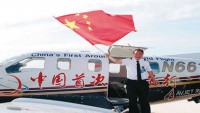Chinese ‘Cupping’ Therapy Makes Waves at Rio Olympics
| Arthur Dominic Villasanta | | Aug 09, 2016 12:35 AM EDT |
(Photo : Getty Images) Chinese swimmer Wang Qun with huge cupping marks. (Right) How cupping is applied. (Below) American Olympic gold medalist Michael Phelps showing his cupping marks.
The ancient Chinese muscle therapy called "cupping" evidenced by huge, round purple blotches on the skin of some Chinese and American athletes, is creating media waves at the ongoing 2016 Summer Olympics at Rio de Janeiro in Brazil.
This therapy, which was begun by the Egyptians in 1550 BC and later made famous by the Chinese, became viral when huge circular cupping marks were seen on the shoulders and arms of legendary American swimmer, Michael Phelps, who has won 19 Olympic swimming gold medals since 2008. Phelps has admitted to be a believer in cupping.
Like Us on Facebook
"It's very much common in our practice,'' said Ralph Reiff, executive director of the St. Vincent Sports Performance in Indianapolis. "We've found it to be an effective alternative therapy to add to our toolkit of resources.''
The huge skin blotches caused by cupping have been humorously described as "giant hickeys" (kiss marks) or monstrous chickenpox scars, among others.
Cupping is described as an Egyptian/Chinese traditional medicine technique that allegedly relieves ailments including back neck and shoulder pain. The Chinese claim cupping is said to move energy, or "qi," in the body. The therapy is also widely used in folk medicine in eastern Europe.
The Chinese, who have been using cupping for thousands of years, describe it as a form of acupuncture where hot cups are placed on the skin to create a vacuum. They believe cupping helps mobilize blood flow to promote muscle healing. The process is painless but those huge purple blotches make it appear otherwise.
In the Chinese technique, cupping works by creating a vacuum inside an earthen or glass cup by inserting a flame, removing it and quickly placing the cup on to the body before the vacuum is lost.
In the West, therapists replace the earthen or glass cup with plastic cups and the flame with a suction device.
Generally, however, western doctors frown on cupping and say it has no proven medical benefits. Medical societies are skeptical of the health claims made by cupping therapy supporters.
"Available scientific evidence does not support cupping as a cure for cancer or any other disease," said the American Cancer Society. "Reports of successful treatment with cupping are mainly anecdotal rather than from research studies."
Tagscupping, 2016 Summer Olympics, michael phelps, traditional medicine technique
©2015 Chinatopix All rights reserved. Do not reproduce without permission
EDITOR'S PICKS
-

Did the Trump administration just announce plans for a trade war with ‘hostile’ China and Russia?
-

US Senate passes Taiwan travel bill slammed by China
-

As Yan Sihong’s family grieves, here are other Chinese students who went missing abroad. Some have never been found
-

Beijing blasts Western critics who ‘smear China’ with the term sharp power
-

China Envoy Seeks to Defuse Tensions With U.S. as a Trade War Brews
-

Singapore's Deputy PM Provides Bitcoin Vote of Confidence Amid China's Blanket Bans
-

China warns investors over risks in overseas virtual currency trading
-

Chinese government most trustworthy: survey
-

Kashima Antlers On Course For Back-To-Back Titles
MOST POPULAR
LATEST NEWS
Zhou Yongkang: China's Former Security Chief Sentenced to Life in Prison

China's former Chief of the Ministry of Public Security, Zhou Yongkang, has been given a life sentence after he was found guilty of abusing his office, bribery and deliberately ... Full Article
TRENDING STORY

China Pork Prices Expected to Stabilize As The Supplies Recover

Elephone P9000 Smartphone is now on Sale on Amazon India

There's a Big Chance Cliffhangers Won't Still Be Resolved When Grey's Anatomy Season 13 Returns

Supreme Court Ruled on Samsung vs Apple Dispute for Patent Infringement

Microsoft Surface Pro 5 Rumors and Release Date: What is the Latest?













